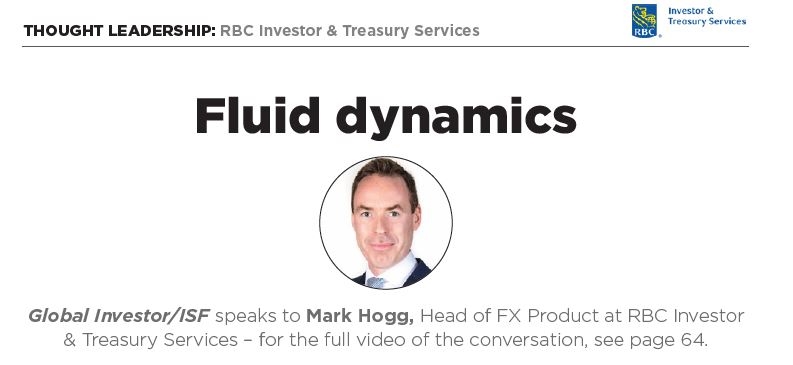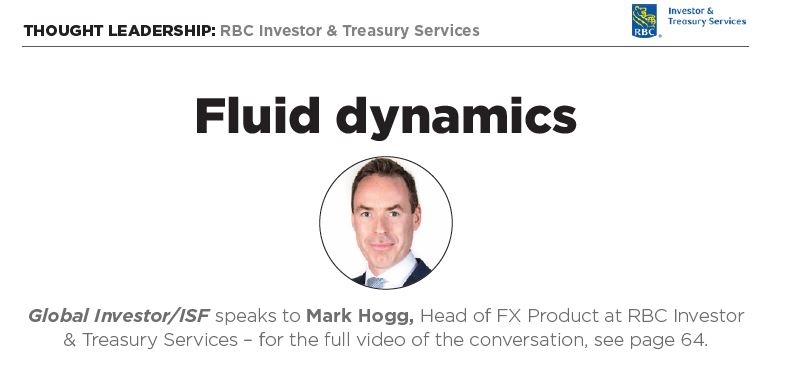Fluid dynamics

A full video of the conversation is available below. A write-up of the interview's highlights also features.
Amelie Labbe: It’s my pleasure to sit down today with Mark Hogg, Head of FX Product at RBC Investor & Treasury Services, who is here with me to discuss a very timely topic: managing currency risk in investor portfolios. Welcome, Mark - could you give our listeners a bit of background on what you do?
Mark Hogg: I’ve been with RBC Investor & Treasury Services for 12 years. In my current role, I’m responsible for the product development and management of a global suite of foreign exchange products and execution services ranging from FX standing instructions to passive currency overlay, and everything in between. I have an amazing team around me whose mission is to provide trusted FX solutions to clients that deliver transparent execution, operational efficiency and leading digital experiences.
As a starting point, could you tell us a bit more about how recent interest rate movements have impacted and will potentially impact investors, and the way they manage currency risk in these portfolios?
We’re at a crossroads in the markets where the very low interest rate environment we’ve all become accustomed to is coming to an end. We can already see a big shift in the sentiment coming from markets, and central banks raising rates aggressively and responding to significant inflation threats.
When you look ahead, there’s a difficult job for policymakers trying to set monetary policy that is going to help dampen or contain all these inflationary pressures while trying to minimise the damage to economic growth. We’re going to have to get used to this so-called new normal rate environment.
In many ways, the environment we are moving into is probably much more in tune with long-term historical standards than the last period - by that, I mean rates in the region of three, four or five percent.
But if we turn this back, what does this mean when we think about currency risk management?
Firstly, we need to look at how differences in interest rates are going to become a much more central factor in currency hedging decisions. For example, if we look at hedging a US dollar asset position to Europe, which is something a lot of people are looking to do now because EUR/ USD is so close to parity, people are looking to take advantage of that US dollar strength. Standard FX forwards markets are pricing in that by the end of this year US interest rates are going to be 2.5% higher than Europe. That’s really because the market is forecasting the Fed is going to ratchet up at a much faster pace than the European Central Bank
Those differences are going to have a greater weight in your decision making.
The other point I would make is that we need to plan for much more volatility in interest rate forecasts: the market is finding itself in unfamiliar territory where it’s having to price in a long series of rate increases into the future.
We can expect plenty of price fluidity and uncertainty around these predictions as we move forward from here: you only have to look at the ECB yesterday
A last word is that I think we can expect continued significant volatility in spot rates. The search for yield has always driven currency flows and that’s going to accelerate now. Overlay that with uncertain central bank actions and volatility in markets more generally, as all asset classes adjust to this new environment, and we’re in for a period of potentially big moves in FX rates in the months ahead.
If we look specifically at investor portfolios: how are these reacting to interest rate rises and related currency risk? Do you expect any shift towards a particular asset or asset class?
It’s been a difficult time for investors. Most equities and fixed income portfolios are returning big losses year-to-date.
Interest rates and bond yields are starting to increase, in some cases to levels not seen for many years, so the relative attractiveness of fixed income is much more interesting for the average investor. This could bring fresh inflows into fixed income security funds.
I also expect that some investors might have capitulated and literally been scared off equities, having experienced significant short-term losses. It might be the first time they’ve experienced that, so they are reassessing their risk appetite, what they’re looking at, and maybe going forward, looking at lower volatility investment options.
One way to do that is to spread the risk over a global portfolio of fixed income securities in search of more stable and predictable returns. In that scenario, we’d be focused on the currency risk component of translating those foreign currency bonds back to the home currency as this can be a very significant driver of risk and returns.
It’s reasonable to think we might see more demand for product providers to deliver currency hedging, or currency-hedged solutions in that space to give investors the choice of currency risk and separate that out from their chosen asset class.
We’ve just talked about specific asset classes but if we look at specific markets: for asset owners and their investment managers, what are some that are going to become less/more appealing because of these currency moves?
FX markets are testing ranges that we’ve not seen in major currency pairs like GBP vs USD, for example: right now, it’s hovering around lows we haven’t seen since the Brexit vote. You must go all the way back to the 1980s to see the pound lower against the dollar. A lot of people have been watching EUR vs USD recently and traded that parity: you must go back 20 years since the last time we saw that. These are the types of big moves that really impact long-term investment returns when you invest in foreign currency assets.
We could also look at emerging market currencies where some of these moves are even bigger - more popular markets like Brazil, India, Turkey and South Africa. Their currencies continue trending lower in the long term. While you might expect that being in these markets might mean you experience good or higher returns in local currency terms, you’re certainly losing ground in your own currency by the time you’ve factored in the depreciation of that local currency into your decision making.
We’d encourage asset allocators to think of this: it’s not only about where you invest and what asset class you chose. An investor could make a great return on investment only to see those gains drain away by negative translation back to their base currency. A better question that could be asked is: should we be thinking about separating those decisions into asset and currency and then manage the risk appetite for each component separately?
If you’re an investment manager, then I would say make it easy for your clients to access your products in a currency-hedged format so that they can be empowered to tailor their own appetite for investment risk. They might say: I want to invest in US equities, but I don’t want US dollar exposure. Allow them to make that decision to separate those things.
When clients come to you, what are some of the common queries you get from them when it comes to managing this category of risk?
This is something we give a lot of thought to. We try and group our queries and challenges into themes, and stay in front of them and ensure that our solutions deliver real utility for our clients.
Some of the more common enquiries we get include product oversight, and access to data, transaction level data. You really need a range of solutions to cater for different user groups. Some clients are very sophisticated, and they simply want access to raw data on an API. Some prefer scheduled reporting via email or SFTP. Others like a dashboard, and the ability to log in and have it all presented or bundled with nice tools and ways to visualise the data. You must cater for all these different user groups.
Another common theme that we see is around execution performance. For that we enlist the support of specialist transaction cost analysis providers, and that update was a very popular component or add-on to our currency hedging product. We also see that while demand for currency hedging continues to rise, a lot of clients want to understand variance in hedge performance - requiring more support to understand the various drivers and the components for performance between a currency-hedged and unhedged investment.
It can take quite a great deal of complex analysis to answer those questions. On the surface intuitively, it’s a straightforward topic but it’s quite a detailed process to get it right. A lot of clients are looking for support in that space.
You just mentioned complex analysis. To finish our chat this morning, what kind of guidance can you give asset owners who want to manage currency risk and their related hedging programmes, dependent on individual risk appetite?
It goes without saying but you must pay attention to all your costs. For example, don’t only focus on execution fees or overly simplified KPIs. The quality of the core market execution, the core market rate is just as important.
Poor market execution may end up costing more than a small fee compared with a competitive market rate that’s transparent and referenced off an independent benchmark or supported by transaction cost analysis. Always aim for the lowest all-in cost outcome.
Be honest and rigorous in measuring and attributing all your costs. The actual market execution cost of a trade in terms of spread to mid is just a small part of the overall cost of a trade. You need to factor in all the direct and indirect overhead costs involved in running a currency management function.
I would also recommend staying on top of technology and innovation. Digital technology solutions have been great at automating workflows and processes, but they can be a bit of a black box. Be careful not to sacrifice control or oversight. If it’s done right, you can get the best of both worlds. There are many intelligence and data-led insights that can be extracted from these processes providing the correct process is in place.
The last point I would make is consciously decide what you’re good at. Where currency risk management isn’t a core competency within your organisation, or not mission critical to your investment strategies, then partner with an expert whose job it is to do this. Choose a partner that does all the basics well, and manages your day-to-day operations, pain and hassle-free.
Found this useful?
Take a complimentary trial of the FOW Marketing Intelligence Platform – the comprehensive source of news and analysis across the buy- and sell- side.
Gain access to:
- A single source of in-depth news, insight and analysis across Asset Management, Securities Finance, Custody, Fund Services and Derivatives
- Our interactive database, optimized to enable you to summarise data and build graphs outlining market activity
- Exclusive whitepapers, supplements and industry analysis curated and published by Futures & Options World
- Breaking news, daily and weekly alerts on the markets most relevant to you





